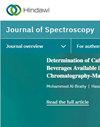便携式近红外光谱仪与多变量数据分析鉴别定量肥料掺假的可行性研究
IF 2.1
4区 化学
Q4 BIOCHEMICAL RESEARCH METHODS
引用次数: 1
摘要
全球人口增长的增加要求通过正确确定真正的肥料来有效地管理农业用地。本研究利用740-1070 nm波长范围内的便携式近红外光谱技术,结合最优的多元算法,开发了一种快速现场检测技术,以识别肥料完整性(未过期、过期和掺假),并量化掺假水平(10-50%)。基于支持向量机(SVM)和随机森林(RF)建立近红外模型进行识别,并使用不同类型的偏最小二乘回归(PLS, iPLS, Si-PLS和GaPLS)进行量化。根据模型的识别率(Rt)、预测相关系数(Rpre2)和预测均方根误差(RMSEP)对模型进行评价。对于肥料完整性的识别,在采用的数学预处理中,一阶导数(FD)和支持向量机(SVM)在校准集和预测集上的识别率都在99.20%以上。结果表明,Si-PLS在两种肥料中具有较好的预测潜力,Rpre2 = 0.95 ~ 0.98, RMSEP = 0.069 ~ 0.11。结果表明,手持式近红外光谱仪配合适当的算法可实现现场快速测定肥料完整性。本文章由计算机程序翻译,如有差异,请以英文原文为准。
Feasibility Study on the Use of a Portable NIR Spectrometer and Multivariate Data Analysis to Discriminate and Quantify Adulteration in Fertilizer
The rise in population growth worldwide requires efficient management of agricultural lands through the correct determination of authentic fertilizers. In this current study, a rapid on-site detection technique was developed by using portable NIR spectroscopy in the wavelength range of 740–1070 nm together with optimum multivariate algorithms to identify fertilizer integrity (unexpired, expired, and adulterated) as well as quantify the levels (10–50%) of adulteration. NIR models were built based on support vector machine (SVM) and random forest (RF) for identification, while different types of partial least square regression (PLS, iPLS, Si-PLS, and GaPLS) were used for quantification purposes. The models were evaluated according to identification rate (Rt), coefficient of correlation in prediction (Rpre2), and root mean square error of prediction (RMSEP). For the identification of the integrity of the fertilizer, among the mathematical pretreatments used, the first derivative (FD) together with SVM gave above 99.20% identification rate in both calibration and prediction sets. For the quantification of the adulterants, Si-PLS was found to be superior and showed an excellent predictive potential of Rpre2 = 0.95–0.98 and RMSEP = 0.069–0.11 for the two fertilizer types used. The overall results indicated that a handheld NIR spectrometer together with appropriate algorithms could be employed for fast and on-site determination of fertilizer integrity.
求助全文
通过发布文献求助,成功后即可免费获取论文全文。
去求助
来源期刊

Journal of Spectroscopy
BIOCHEMICAL RESEARCH METHODS-SPECTROSCOPY
CiteScore
3.00
自引率
0.00%
发文量
37
审稿时长
15 weeks
期刊介绍:
Journal of Spectroscopy (formerly titled Spectroscopy: An International Journal) is a peer-reviewed, open access journal that publishes original research articles as well as review articles in all areas of spectroscopy.
 求助内容:
求助内容: 应助结果提醒方式:
应助结果提醒方式:


